The next-gen MacBook Pro with Retina Display Review
by Anand Lal Shimpi on June 23, 2012 4:14 AM EST- Posted in
- Mac
- Apple
- MacBook Pro
- Laptops
- Notebooks
Last year when I wrote about the new MacBook Airs I offered two forward looking paragraphs:
What happens from here on out is what's really interesting. Intel has already committed to moving the TDP of its mainstream parts from 35W - 45W down to 10 - 20W. Since the Air is the new mainstream Mac notebook, Apple has already made that move. The performance in this 10 - 20W segment is going to get much better over the next two years, particularly once Haswell arrives.
The Thunderbolt Display is the first sign of what's to come. Moving IO controllers and expansion into the display, and potentially even moving discrete GPUs out of the notebook are all in store for us. Apple is really ahead of the curve here, but it's easy to imagine a future where laptops become a lot more like the new Air and shift to a couple high bandwidth ports instead of numerous lower bandwidth connections.
Perhaps I was being too aggressive in the prediction of a couple of high bandwidth ports. After all, the next-generation MacBook Pro with Retina Display features four such IO ports (2 x Thunderbolt and 2 x USB 3.0). But you get my point. Gigabit Ethernet and Firewire 800 are both gone. The discrete GPU is still present but I suspect even its days are numbered, at least inside the chassis. The personal computer as we knew it for so long, is changing.
The personal computer is getting thinner, lighter, more integrated and more appliance-like. The movement is no longer confined to just Apple either. The traditional PC OEMs are following suit. Even Microsoft has finally entered the PC hardware business, something it threatened to do for years but hadn't until now. Distribution models will change, the lines between different form factors will continue to blur. What was once a mature industry is going through a significant transformation. It’s exciting but at the same time it makes me uneasy. When I first got into this industry everyone had stories of companies with great ideas that just didn’t make it. As we go through this revolution in computing I’m beginning to see, first hand, the very same.
Apple makes the bulk of its revenue from devices that don’t look like traditional personal computers. For the past couple of years I’ve been worried that it would wake up and decide the traditional Mac is a burden, and it should instead be in the business of strictly selling consumer devices. With its announcements two weeks ago in San Francisco, I can happily say that my fears haven’t come true. At least not yet.
It’s been a while since Apple did a really exciting MacBook Pro launch. Much to my surprise, even the move to Sandy Bridge, the first quad-core in a MacBook Pro, was done without even whispers of a press conference. Apple threw up the new products on its online store, shipped inventory to its retail outlets, updated the website and called it a day. Every iPhone and iPad announcement however was accompanied with much fanfare. The MacBook Pro seemed almost forgotten.
With its WWDC unveil however Apple took something that it had resigned to unexciting, dare I say uncool status, and made a huge deal about it. Two weeks ago Apple did the expected and offered relatively modest upgrades to all of its portable Macs, all while introducing something bold.
Apple calls it the MacBook Pro with Retina Display. You’ll see me refer to it as the next-gen MacBook Pro, Retina MacBook Pro, rMBP or some other permutation of these words.
After using it for the past two weeks I can honestly say it’s the best Mac Apple has ever built. And there’s a lot more to it than hardware.
Portability
If you were hoping for a 15-inch MacBook Air, that’s not what the rMBP is. Instead it is a far more portable 15-inch MacBook Pro. I have to admit I was a bit let down the first time I laid eyes on the next-gen MacBook Pro, it looks good but it doesn’t look all that different. The disappointment quickly faded as I actually picked up the machine and started carrying it around. It’s not ultra light, but man does it make the previous chassis feel dated.
While I never really liked lugging around the old MBP (and it always made me feel like the old fogey at tradeshows where everyone else had something 13-inches or smaller), carrying the rMBP is a pleasure by comparison. Pictures really don’t do it justice. The impressively thin display assembly or overall chassis thickness look neat in a photo but it’s not until you actually live with the rMBP that you can appreciate what Apple has done here. I carry around a 15-inch MacBook Pro because it’s my desktop, and as such it’s incredibly useful to have with me when I travel. For my personal usage model, the Retina MacBook Pro is perfect.
If your workload demands that you need the performance of a MacBook Pro and your lifestyle requires you to carry it around a lot, the reduction in thickness and weight alone will be worth the upgrade to the rMBP. If you spend most of your time stationary however, you’ll have to be sold on the display and internal characteristics alone. The bad news is if the design doesn’t get you, everything else will.

From left to right: 11-inch MacBook Air, 13-inch MacBook Air, 15-inch MacBook Pro, MacBook Pro with Retina Display
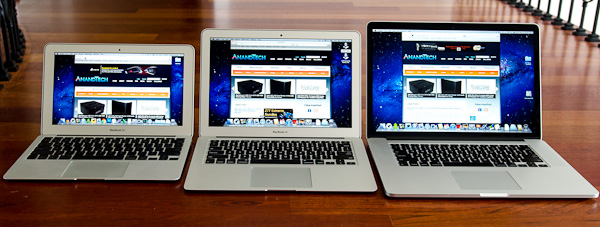
From left to right: 11-inch MacBook Air, 13-inch MacBook Air, MacBook Pro with Retina Display
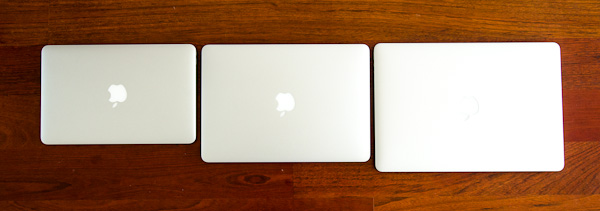
From left to right: 11-inch MacBook Air, 13-inch MacBook Air, MacBook Pro with Retina Display


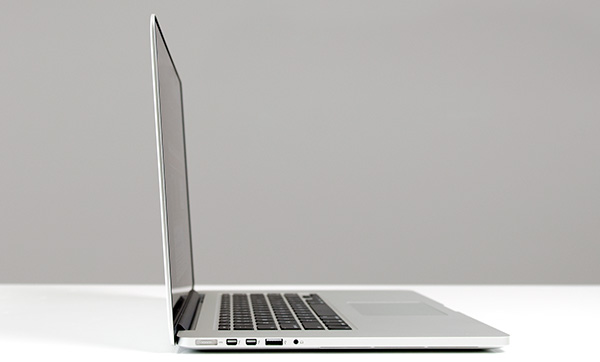
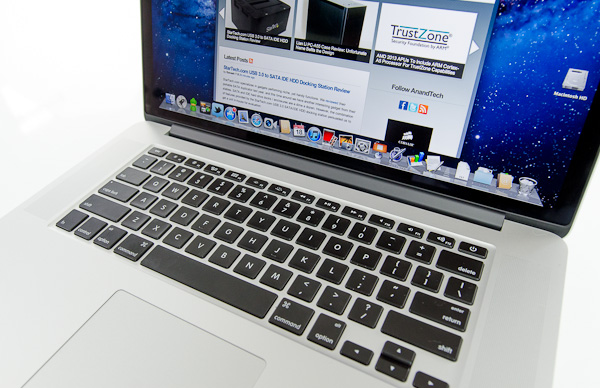
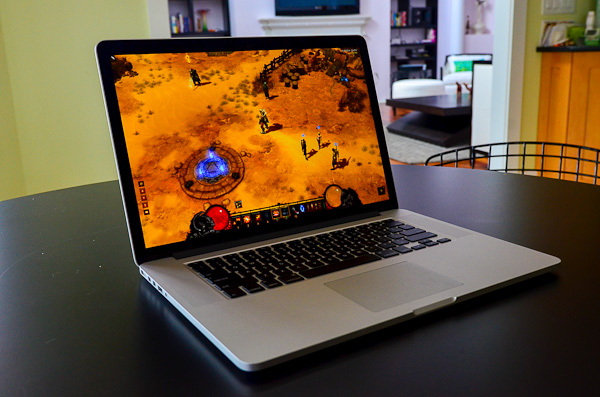
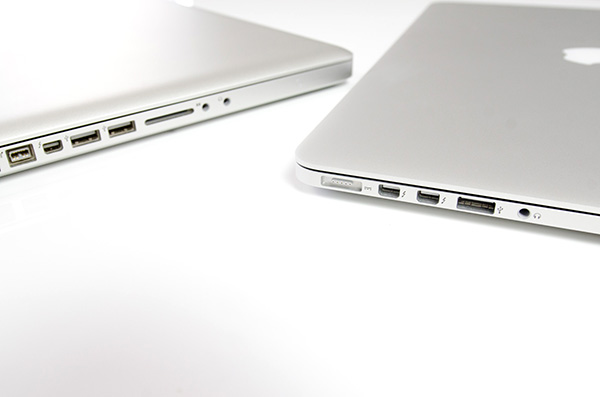
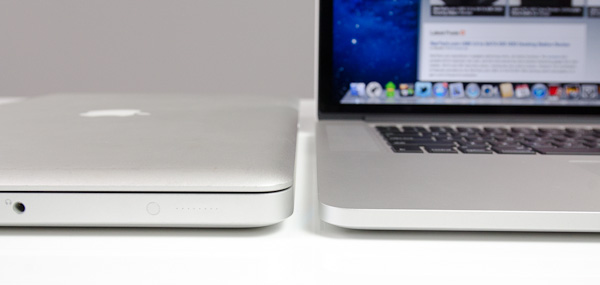








471 Comments
View All Comments
dannyboy153 - Saturday, June 23, 2012 - link
The Sony Z is more of a "consumer" laptop than a creative laptop. Here's why:1) The 1080p (9x16) LCD is great for watch movies but the loss in 1" vertical height is annoying.
2) No discrete GPU built into the Laptop.
3) No high res output. VGA and HDMI doesn't cut it. I have no idea why their dock doesn't have DVI or display port even though it's equipped with a discrete GPU. Their implementation of the dock is admirable, but it's filled with bugs. Read the reviews.
I'll have to admit the MBP is heavier by almost 2x the weight of the Sony Z. But at ~4.5 lbs, it's not overly heavy. MBP advantage:
1) None of the disadvantages of 1-3 above.
2) 15.4" screen is HUGE for me (coming form an X200). Also, it's like the best of both worlds for glossy and matte LCDs; beautiful and vastly reduced glare.
3) The Sony Z has a quad core but the MBP is more powerful. Notice I didn't mention the weaker Quad core of the Sony Z as one of its disadvantage because I believe it's hard enough for them to even offer such power in their laptop.
ananduser - Saturday, June 23, 2012 - link
The 2010 VaioZ had discrete video, 1080p screen, quad raid SSD option. blu ray, slim profile, etc.The 2012 VaioZ does not have discrete built in, only via external dock.
So...considering what the Z was for 2010, Anand never sang such high praises for it. Why ? Because he's a macuser and couldn't care less about another company's efforts.
OCedHrt - Sunday, June 24, 2012 - link
http://www.anandtech.com/show/5430/sony-vaio-z-wit...They did eventually do a review of the 2011/2012 Z, however they're not as tolerant of small faults as they are with apple products.
I remember back in the day when Anand would wipe the floor about keyboards not having enough pitch. But on the macbook pro retina the reduced pitch is just "different" not terrible.
gstrickler - Sunday, June 24, 2012 - link
The MBP keyboard doesn't have reduced pitch, it's a standard 19mm pitch. It has slightly reduced key travel.OCedHrt - Monday, June 25, 2012 - link
Sorry I meant key travel. Incorrect use of terms on my part.dannyboy153 - Sunday, June 24, 2012 - link
For 2010, there were plenty of laptops with 1080p. Name one laptop now with the Apple's display. The Z is a great laptop if you're a consumer of media. But for creators, the Apple is superior.Spunjji - Monday, June 25, 2012 - link
Name another *13"* laptop in 2010 with 1080p. Go on. We can play this game all day!SanX - Saturday, June 23, 2012 - link
hdmi can not handle 1080 output?dannyboy153 - Sunday, June 24, 2012 - link
I don't consider 1080p hi res. At a minimum it has to be at least 1200p in 10x16 format for 24" monitors. For the price of the Sony Z, not being able to do 2560x1600 is a shame.OCedHrt - Monday, June 25, 2012 - link
Reading on forums there doesn't seem to be any issues with 1920x1200 external output, but 2560x1600 does not work without a hack for reduced refresh rate.